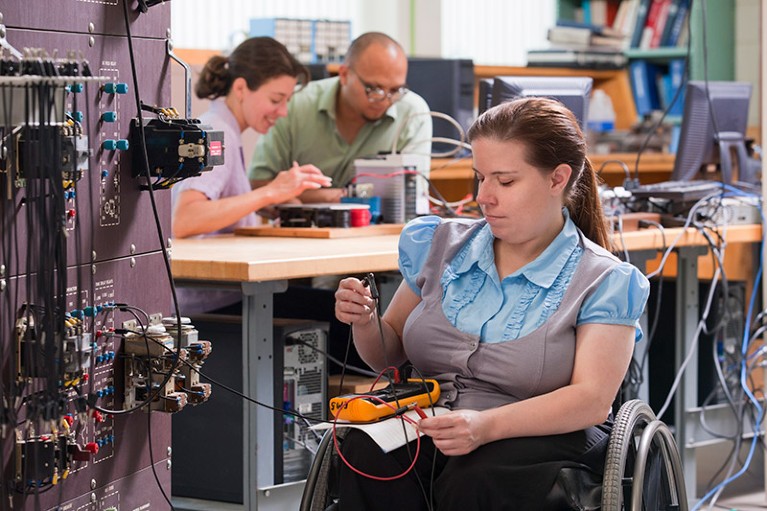
People with disabilities make up about 10% of the workforce in science, technology, engineering and mathematics in the United States.Credit: Huntstock/Getty
Scientists and engineers with long-term disabilities earn, on average, US$10,580 less per year than their non-disabled peers, finds a massive survey of people with PhDs in science, technology, engineering and mathematics (STEM) in the United States.
The researchers also found that disabled people who work in STEM roles in academia, in particular, have a larger salary gap than those working in other STEM sectors. On average, they earn $14,360 less than their non-disabled counterparts. The study, published1 in Nature Human Behaviour on 27 November, analysed survey data from 704,013 people with STEM PhDs and working in jobs related to their expertise.
“It’s a wake-up call. These are the outcomes that we get of this system,” says Jay Dolmage, a disability-rights researcher at the University of Waterloo in Ontario, Canada. “It’s almost irresponsible that we don’t have more disciplinary research along these lines, that we aren’t asking these kinds of questions, that it’s not transparent to folks, and it still comes as a surprise,” he adds.
Ranking activities
Previous studies have reported pay gaps for women in STEM, who earn on average US$25,000 less than men, and for under-represented racial minorities, who are paid around $15,000 less per year compared with their White colleagues. Less work has looked at the disability gap.
The authors used data from a 2019 survey by the US National Science Foundation, which included more than one million people who received STEM PhDs from US universities between 1973 and 2017. They compared the annual incomes for people in full-time jobs across STEM fields.
About 57,000 respondents reported having disabilities early or later in life. Respondents reported their disabilities by ranking how difficult they found activities such as seeing, hearing, walking, lifting and remembering, as a result of physical, mental or emotional conditions.
The authors studied a subset of 219,413 participants who worked at academic institutions in STEM roles. They found that disabled academics were under-represented in senior faculty positions. Whereas 10% of people who work in STEM jobs are disabled, only 6.5% of surveyed professors, 9.4% of tenured academics, and 5.9% of deans and presidents reported having a disability. (In the United States, more than one-quarter of the population is disabled.)
The authors suggest that this under-representation partly explain the pay gap. Under-representation means there are few disabled mentors for early-career researchers and students, and there is likely to be unequal access to tools that build research skills, such as networking and collaboration opportunities.
Disclosure culture
These issues stem from an ableist culture at academic institutions, says study co-author Bonnie Swenor, an epidemiologist who is director of the Johns Hopkins University Disability Health Research Center in Baltimore, Maryland. “The expectation is that we won’t be there. So, STEM has not been designed to include us.”
Part of the problem is that many people are afraid to report their disabilities at work. “There’s still not a good culture of disclosure,” says Swenor. Many surveys that collect workforce data do not cover all types of conditions, such as learning difficulties.
Many universities also lack clear disclosure policies that protect confidentiality, says Dolmage. “The first step would be truly having policies for staff and faculty that protect their confidentiality, and this includes that their accommodations are provided to them in a way that doesn’t impact their careers,” he adds.
Although diversity, equity and inclusion policies are widespread, these efforts should do more to include disabled people — especially at career-level, say researchers. “The representation will be low until something changes,” says Swenor. “As long as that keeps happening, we’re going to continue to be missing out on a large group of innovative professionals.”

